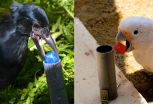(Press-News.org) Stanford scientists have found evidence that sections of the fault responsible for the 9.0 magnitude Tohoku earthquake that devastated northern Japan in 2011 were relieving seismic stress at a gradually accelerating rate for years before the quake.
This "decoupling" process, in which the edges of two tectonic plates that are frictionally locked together slowly became unstuck, transferred stress to adjacent sections that were still locked. As a result, the quake, which was the most powerful ever recorded to hit Japan, may have occurred earlier than it might have otherwise, said Andreas Mavrommatis, a graduate student in Stanford's School of Earth Sciences.
Mavrommatis and his advisor, Paul Segall, a professor of geophysics at Stanford, reached their conclusions after analyzing 15 years' worth of GPS measurements from the Japanese island of Honshu. Their results were published earlier this year in the journal Geophysical Research Letters.
"We looked at northeastern Japan, which has one of the densest and longest running high-precision GPS networks in the world," Mavrommatis said.
Segall said, "The measurements indicated the plate boundary was gradually becoming less locked over time. That was surprising."
The scientists will present their work, "Decadal-Scale Decoupling of the Japan Trench Prior to the 2011 Tohoku-Oki Earthquake from Geodetic and Repeating-Earthquake Observations," Dec. 17 at the American Geophysical Union's Fall Meeting in San Francisco. The talk will take place at 5 p.m. PT at the Moscone Convention Center in Moscone South, Room 306.
The pair's hypothesis is further supported by a recent analysis they conducted of so-called repeating earthquakes offshore of northern Honshu. The small quakes, which were typically magnitude 3 or 4, occurred along the entire length of the fault line, but each one occurred at the same spot every few years. Furthermore, many of them were repeating not at a constant but an accelerating rate, the scientists found. This acceleration would be expected if the fault were becoming less locked over time, Mavrommatis said, because the decoupling process would have relieved pent-up stress along some sections of the fault but increased stress on adjacent sections.
"According to our model, the decoupling process would have had the effect of adding stress to the section of the fault that nucleated the Tohoku quake," Segall said. "We suspect this could have accelerated the occurrence of the earthquake."
The scientists caution that their results cannot be used to predict the occurrence of the next major earthquake in Japan, but it could shed light on the physical processes that operate on faults that generate the world's largest quakes.
INFORMATION:
WASHINGTON, Dec. 15, 2014--Credit card fraud and identify theft are serious problems for consumers and industries. Though corporations and individuals work to improve safeguards, it has become increasingly difficult to protect financial data and personal information from criminal activity. Fortunately, new insights into quantum physics may soon offer a solution.
As reported in The Optical Society's (OSA) new high-impact journal Optica, a team of researchers from the Netherlands has harnessed the power of quantum mechanics to create a fraud-proof method for authenticating ...
A survey of more than 300 college students reveals that college students who use "fake weed" or synthetic THC are most likely to have tried the drug because they were curious. Rebecca Vidourek, a University of Cincinnati assistant professor of health promotion and assistant director of the Center for Prevention Science; Keith King, a UC professor of health promotion and director of the Center for Prevention Science; and Michelle Burbage, a graduate student and graduate assistant for UC's Health Promotion and Education Program, published their findings in the current issue ...
This news release is available in French. "Media reports about behavioural genetics unintentionally induce unfounded beliefs, therefore going against the educational purpose of scientific reporting," writes the University of Montreal's Alexandre Morin-Chassé, following his study of 1,500 Americans. "Among other things, we wanted to know if the public understood (or misunderstood) popular science articles about a new research field, genopolitics, and whether this popularization indeed helped people have an informed opinion on human genetics," Morin-Chassé explained.
The ...
This news release is available in German. The ways animals play with inedible objects may be precursors of functional behaviors such as tool use and goal directed object manipulation. For these reasons, species of high technical intelligence are also expected to play intensely with inanimate objects when no obvious goal is pursued. Within object play, combinatory actions are considered a particularly informative trait in animals as well as human infants: Children start bashing two objects together when they are about 8 months old, at 10 months, they combine toys with ...
A study conducted by University of Granada scientists (from the Physiology, Obstetrics and Gynaecology Departments) and from the San Cecilio Clinical Hospital (Granada) has demonstrated that delaying the cutting of the umbilical cord in newborns by two minutes leads to a better development of the baby during the first days of life.
This multidisciplinary work, published in the prestigious journal Pediatrics reveals that the time in cutting the umbilical cord (also called umbilical cord clampling) influences the resistance to oxidative stress in newborns.
For this research, ...
In medicine, X-rays provide high-resolution images of our insides to help doctors make a definitive diagnosis. Industry uses X-rays, too - as a reliable, non-destructive way of seeing what's hidden on inside materials and components and to check for cracks or irregularities. However industry additionally draws upon different technologies that are not used in the medical field. Whereas medical X-ray machines have been specifically designed for human test subjects, industrial X-ray machines are used to analyze objects that vary much more in their size and material composition. ...
MANHASSET, NY -- Molecular Medicine, a peer-reviewed biomedical journal published by the Feinstein Institute Press, published the results of a new study reporting clinically significant pain reduction in type 2 diabetic patients. In an exploratory study conducted by Araim Pharmaceuticals, a biotech company developing novel treatments for chronic diseases, investigators also observed improvements in metabolic control in patients administered ARA 290. ARA 290 is a peptide engineered to activate the innate repair receptor, a receptor discovered by Araim scientists, which is ...
Scientists at Johannes Gutenberg University Mainz (JGU) in Germany have discovered a new signal pathway in the brain that plays an important role in learning and the processing of sensory input. It was already known that distinct glial cells receive information from neurons. However, it was unknown that these same glial cells also transmit information to neurons. The glia release a specific protein fragment that influences neuronal cross-talk, most likely by binding to the synaptic contacts that neurons use for communication. Disruption of this information flow from the ...
New research led by the University of Exeter has found that people who have a stronger sense of place at the global than the national level are more likely to accept that climate change is caused by human activities. This is the first time that acceptance of human causes of climate change has been shown to be linked to people's sense of place at the global level. The findings have significant implications both for climate change communications and for our understanding of place and identities.
The study 'My country or my planet? Exploring the influence of multiple place ...
BLOOMINGTON, Ind. -- Scientists at Indiana University and colleagues at Stanford and the University of Texas have demonstrated a technique for "editing" the genome in sperm-producing adult stem cells, a result with powerful potential for basic research and for gene therapy.
The researchers completed a "proof of concept" experiment in which they created a break in the DNA strands of a mutant gene in mouse cells, then repaired the DNA through a process called homologous recombination, replacing flawed segments with correct ones.
The study involved spermatogonial stem ...




